九年级英语下册unit1教案
- 格式:docx
- 大小:25.92 KB
- 文档页数:10

Un itl How do you study for a test ?I . Analysis of the Teaching MaterialsIn this un it, stude nts lear n to talk about how to study. Such topic is very useful to stude nts. It ' s helpful to raise learning interest of all the students. Either more or less advaneed stude nts will ben efit a lot.1. The first period mainly gives students listening and oral practice using the targetIan guage "How do you study for a text? I study by doing …".2. The sec ond period gives stude nts more liste ning and oral practice using more targetIan guages. They are helpful to improve stude nts ' liste nin gpsnkisg skills.3. In the third period, students learn to get detailed information from an article. It is a basicreadi ng skill and is a great help to improve stude nts ' readi ng skills.4. The fourth period not only introduces some new words but also provides students with many differe nt kinds of activities. In this class, stude nts lear n to give advice to those who have difficulty in study ing .5. The fifth period is desig ned to train stude nts ' readi ng and writi ng skills.n . Language FunctionTalk about how to study.川.Target Language1. How do you study for a test?I study by work ing with frien ds.2. Have you ever studied with a group?Yes, I have. I ' ve learned a lot that way.3. I don ' t have a partner to practise English with.Maybe you should join an En glish Ian guage club.IV. Structureverb + by\ with gerundV . Vocabularyflashcard, take notes, frustrating, memorize, aloud, comma, make mistakes, pronunciation, be afraid to,What about …? Why don ' t you …?W . Teaching TimeFive periodsThe First PeriodI . Teaching AimsI. Key Vocabulary: flashcard2. Target Lan guage: How do you study for a test?___________ I study by work ing with a group.n . Teaching key PointTalk about how to study foa a test.川.Teachi ng MethodTask-based approachV. Teaching Aids1. A tape recorder2. Real objectsV . Teaching ProceduresStep I GreetingsT: Did you have a good time during the summer holidays?Where did you go? What did you do?Ask some stude nts to describe their summer holidays.Step n Lead-inT: Is today a special day?(Lead the students to answer: It ' s the first day of the new term)T: What are your new term ' s resolutions?s ask them (Lead the students to answer: I ' m going to get good grades.)T: Last term,Wa ng L inyuan and Zhao Ting got good grades in En glish; let how to study En glish well.T: Wang Linyuan, how do you study for an En glish test?(With the short con versati ons betwee n the teacher and the stude nts,the teacher lead in thenew text----how to study for a text.) Step 川Teach 1aT: How do you study for a test? (Write on the blackboard)S: I study for a test read the textbook.Teacher correct the an swer: Oh, you study by readi ng the textbook.(Let stude nts give differe nt an swers,a nd emphasize verb+by\with gerun d.)1. Show some real thin gs, like flashcards,tapes, the textbook and vocabulary lists,to in troduce theways in 1a.2. Ask the stude nts to tell other ways of lear ning En glish.Sample an swersa. by joining a study groupb. by practis ing con versati ons with my friendsc. by read ing aloud every morningd. by watch ing En glish-la nguage TVNote:A flashcard is a piece of paper or card which students write a word on and use it to memorize in formati on.Step IV 1bThis activity provides stude nts practice in un dersta nding the target Ian guage in spoke n con versati on.1. Let the stude nts look at the pictures in 1b,ask them to tell the ways of lear ning:by making flashcards, by liste ning to tapes,by ask ing the teacher for help2. liste n to the tape, let stude nts write the correct letters.(Comb ine the liste ning task and speak ing task.)T: You will hear one con versati on. You are asked to write the letter of each picture in front of the n ameof the pers on who studies that way.Point out the sample an swer to the class.T: Mei says, "I study by making flashcards. "so the an swer to nu mber 1 is a.Play the recording for the first time.Students only listen. Play the recording a second time. Students write down their answers.Check the an swers with the whole class.An swers1. a2. c3. bStep V 1cThis activity gives stude nts oral practice using the target Ian guage.Read the in struct ions to the class.1. In vite a pair of stude nts to read the con versati on to the class,S1: How do you study for a test?S2: I study by work ing with a group.2. Write the con versati on on the blackboard. The n dem on strate a new con versati on withano ther stude nt.T: How do you study for a test?S3: I study by making flashcards.3. Stude nts work in pairs ,and excha nge the ways of study ing.As stude nts work, teacher walks around and helps with pronun ciati on as n eeded.4. Ask pairs of stude nts to come to the front of the classroom and act out their con versati ons.'ve Step W SummaryT: In this c lass, we ' ve learned some key vocabulary words, such as flashcard. And we also lear nedthe target Ian guages How do you study for a test? I study by work ing with a group.Step Vfl HomeworkAsk stude nts to in terview stude nts in other classes, family members, and friends to try to discoversome new ways of studying that haven ' t been introduced in the book or in class.Step 忸Blackboard DesignUn it 1 How do you study for a test?Section AThe First Period1. Target la nguagesA: How do you study for a test?B: I study by work ing with a group.2. Ways of study ing:by work ing with Frie ndsby making flashcardsby read ing the textbookby maki ng vocabulary listsby liste ning to tapesby ask ing the teacher for help。
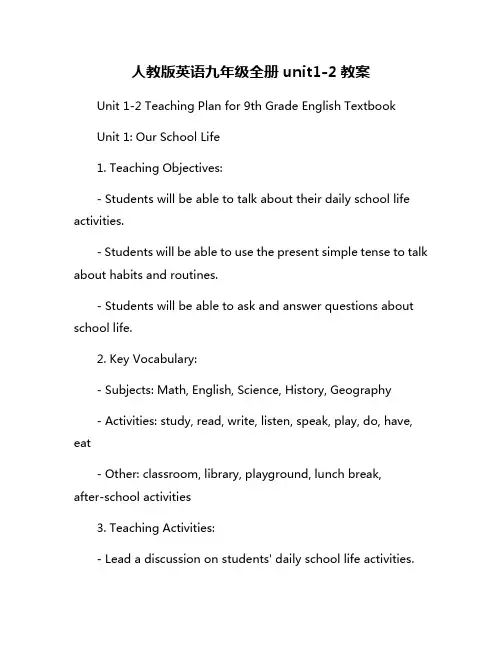
人教版英语九年级全册unit1-2教案Unit 1-2 Teaching Plan for 9th Grade English TextbookUnit 1: Our School Life1. Teaching Objectives:- Students will be able to talk about their daily school life activities.- Students will be able to use the present simple tense to talk about habits and routines.- Students will be able to ask and answer questions about school life.2. Key Vocabulary:- Subjects: Math, English, Science, History, Geography- Activities: study, read, write, listen, speak, play, do, have, eat- Other: classroom, library, playground, lunch break,after-school activities3. Teaching Activities:- Lead a discussion on students' daily school life activities.- Introduce vocabulary and practice pronunciation.- Discuss routines and habits using the present simple tense.- Role-play asking and answering questions about school life activities.- Present a short video or audio clip of a typical school day.- Have students create a daily schedule for themselves and share with the class.4. Assessment:- Quizzes on vocabulary and grammar usage.- Oral presentations of daily schedules.- Written assignments on describing school life activities.Unit 2: The World Around Us1. Teaching Objectives:- Students will be able to talk about different countries and cultures.- Students will be able to use adjectives to describe places and people.- Students will be able to use comparative and superlative forms.2. Key Vocabulary:- Countries: China, Japan, France, Brazil, Australia- Adjectives: beautiful, crowded, modern, traditional, diverse- Comparative and Superlative Forms: bigger, more crowded, most diverse3. Teaching Activities:- Introduce the countries and their cultures through pictures and videos.- Discuss the adjectives used to describe different places and people.- Practice using comparative and superlative forms in sentences.- Have students work in pairs to compare two countries of their choice.- Conduct a class debate on the best country to visit based on the criteria discussed.4. Assessment:- Quizzes on vocabulary and grammar structures.- Written assignments comparing two countries.- Oral presentations on a chosen country's culture and attractions.Overall, the teaching plan for Unit 1-2 of the 9th-grade English textbook focuses on developing students' language skills in talking about daily routines and school life activities, as well as describing different countries and cultures. Through a variety of vocabulary and grammar exercises, as well as interactive activities and discussions, students will be engaged and motivated to learn English in a fun and meaningful way.。
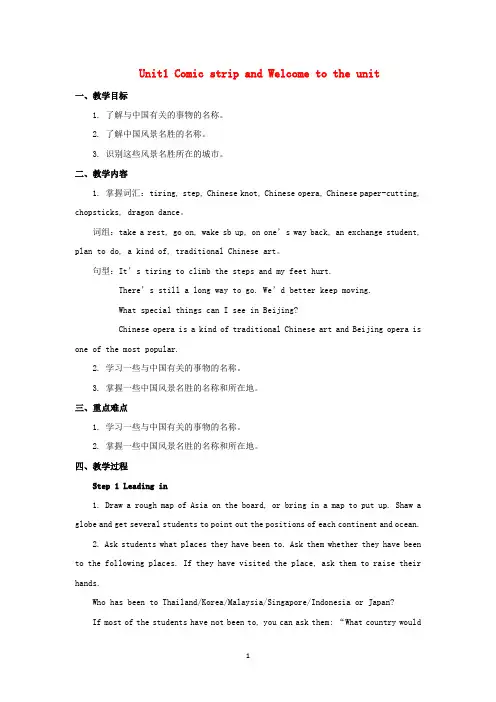
Unit1 Comic strip and Welcome to the unit一、教学目标1. 了解与中国有关的事物的名称。
2. 了解中国风景名胜的名称。
3. 识别这些风景名胜所在的城市。
二、教学内容1. 掌握词汇:tiring, step, Chinese knot, Chinese opera, Chinese paper-cutting, chopsticks, dragon dance。
词组:take a rest, go on, wake sb up, on one’s way back, an exchange student, plan to do, a kind of, traditional Chinese art。
句型:It’s tiring to climb the steps and my feet hurt.There’s still a long way to go. We’d better keep moving.What special things can I see in Beijing?Chinese opera is a kind of traditional Chinese art and Beijing opera is one of the most popular.2. 学习一些与中国有关的事物的名称。
3. 掌握一些中国风景名胜的名称和所在地。
三、重点难点1. 学习一些与中国有关的事物的名称。
2. 掌握一些中国风景名胜的名称和所在地。
四、教学过程Step 1 Leading in1. Draw a rough map of Asia on the board, or bring in a map to put up. Shaw a globe and get several students to point out the positions of each continent and ocean.2. Ask students what places they have been to. Ask them whether they have been to the following places. If they have visited the place, ask them to raise their hands.Who has been to Thailand/Korea/Malaysia/Singapore/Indonesia or Japan?If most of the students have not been to, you can ask them: “What country wouldyou like to visit, Thailand/Korea/Malaysia/Singapore/Indonesia or Japan?”3. As students raise their hands, ask them to come to the front of the class and point to the place on the map. They could mark the place with a pen and label it, or stick a pin in the map.4. Ask students: “Has anyone visited any other countries in Asia? /What other countries would you like to visit in Asia?” Ask students to point out these places as well. Encourage more students to give reasons for their choices.5. If students start pointing out cities and villages they have been to, the exercise could last for a long time.Step 2 Presentation1. Talk about Chinese culture. Ask students to think of some things that China is famous for or that foreigners recognize as being special to China, e.g. : the giant Panda, acupuncture, calligraphy, tea, Taichi, Chinese pottery, Chinese porcelain, Chinese medicine, the Spring Festival, Dragon Boat Festival, Changjiang River, Huanghe River, the Great Wall, Tiananmen Square and so on.Ask students if they know of anything that was invented in China and is now used all over the world, e. g.: compass, gunpowder, silk, paper, printing and so on.2. Present the picture of the Great Wall and ask when Eddie and Hobo are visiting the Great Wall, and what do they think of it?Step 3 Practice1. Present the comic strip and get students to read Eddie and Ho bo’s conversation. Think about the following questions.(1)What does Hobo think of the Great Wall?(He thinks it is amazing.)(2)Does Eddie like visiting the Great Wall?(No, he doesn’t.)(3)Do you think Eddie will continue to the end?(No, I don’t think s o.)2. Make students listen to the conversation without looking. Then answer the above questions.3. Play the tape again for the students to listen and repeat4. Act out the conversation.Step 4 Learn the “Welcome to the unit”1. Explain the context of Part A. Millie is showing a magazine to the British exchange students. It contains pictures of things in China.Ask students to label the pictures in Part A, using words from the box. If students are unsure of any words, encourage them to use a dictionary or guess their meaning(s).When students have finished these tasks, ask 6 students to read out the words. Listen for mistakes and mispronunciations.2. Show the pictures of Tian’anmen Square, the Palace Museum and the Great Wall and so on. Choose a student to read out the names.Briefly introduce above attractions.(1)The Palace Museum is in the middle of the city, Beijing. It has wonderful buildings and art treasures inside. And it is worth visiting.(2)Tian’anmen Square is the largest downtown square in the world. It covers an area of 44 hectares, which is big enough to hold one million people. It is one of the most famous and popular places in China.Step 4 Extension activity1. Ask students what places of interest they have been to in China. List the cities and villages they mentioned on the board.Then ask students to point out the locations on the map and tell the class something about those places.2. Try to write a short passage to introduce a place of interest.Step 5 Homework1. Learn more about things in China.2. Learn more about the names of the places of interest in China五、板书设计。
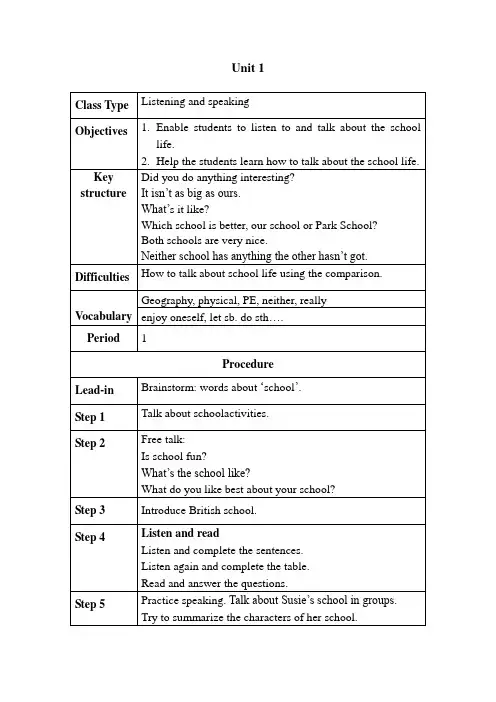
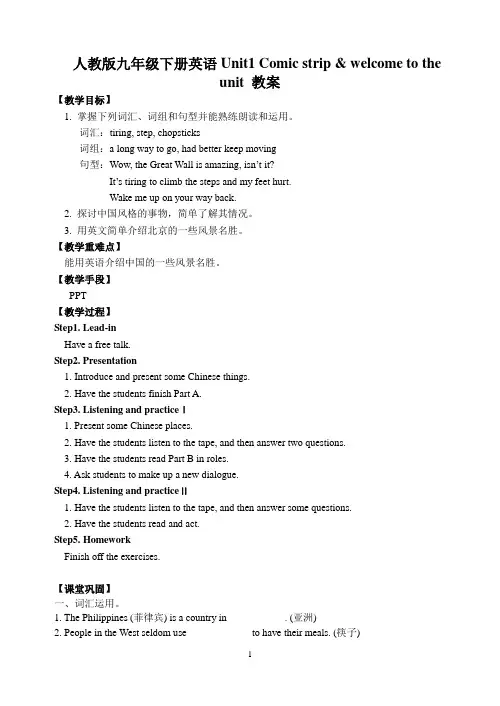
人教版九年级下册英语Unit1 Comic strip & welcome to theunit 教案【教学目标】1. 掌握下列词汇、词组和句型并能熟练朗读和运用。
词汇:tiring, step, chopsticks词组:a long way to go, had better keep moving句型:Wow, the Great Wall is amazing, isn’t it?It’s tiring to climb the steps and my feet hurt.Wake me up on your way back.2. 探讨中国风格的事物,简单了解其情况。
3. 用英文简单介绍北京的一些风景名胜。
【教学重难点】能用英语介绍中国的一些风景名胜。
【教学手段】PPT【教学过程】Step1. Lead-inHave a free talk.Step2. Presentation1. Introduce and present some Chinese things.2. Have the students finish Part A.Step3. Listening and practiceⅠ1. Present some Chinese places.2. Have the students listen to the tape, and then answer two questions.3. Have the students read Part B in roles.4. Ask students to make up a new dialogue.Step4. Listening and practiceⅡ1. Have the students listen to the tape, and then answer some questions.2. Have the students read and act.Step5. HomeworkFinish off the exercises.【课堂巩固】一、词汇运用。
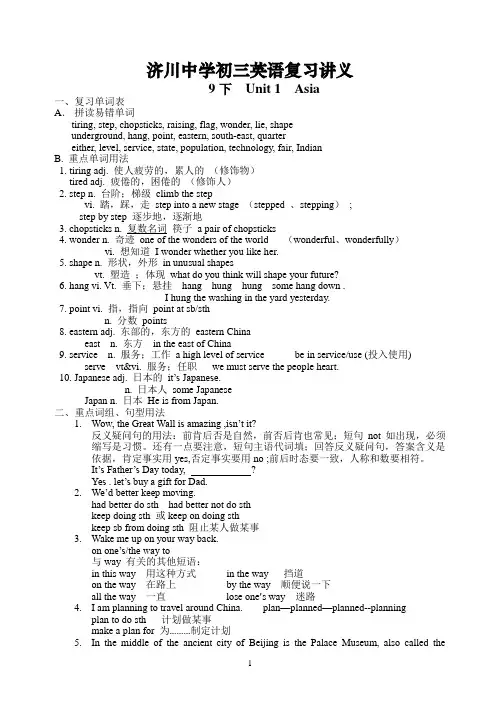
济川中学初三英语复习讲义9下Unit 1 Asia一、复习单词表A.拼读易错单词tiring, step, chopsticks, raising, flag, wonder, lie, shapeunderground, hang, point, eastern, south-east, quartereither, level, service, state, population, technology, fair, IndianB. 重点单词用法1. tiring adj. 使人疲劳的,累人的(修饰物)tired adj. 疲倦的,困倦的(修饰人)2. step n. 台阶;梯级climb the stepvi. 踏,踩,走step into a new stage (stepped 、stepping);step by step 逐步地,逐渐地3. chopsticks n. 复数名词筷子a pair of chopsticks4. wonder n. 奇迹one of the wonders of the world (wonderful、wonderfully)vi. 想知道I wonder whether you like her.5. shape n. 形状,外形in unusual shapesvt. 塑造;体现what do you think will shape your future?6. hang vi. Vt. 垂下;悬挂hang hung hung some hang down .I hung the washing in the yard yesterday.7. point vi. 指,指向point at sb/sthn. 分数points8. eastern adj. 东部的,东方的eastern Chinaeast n. 东方in the east of China9. service n. 服务;工作a high level of service be in service/use (投入使用)serve vt&vi. 服务;任职we must serve the people heart.10. Japanese adj. 日本的it’s Japanese.n. 日本人some JapaneseJapan n. 日本He is from Japan.二、重点词组、句型用法1.Wow, the Great Wall is amazing ,isn’t it?反义疑问句的用法:前肯后否是自然,前否后肯也常见;短句not如出现,必须缩写是习惯。
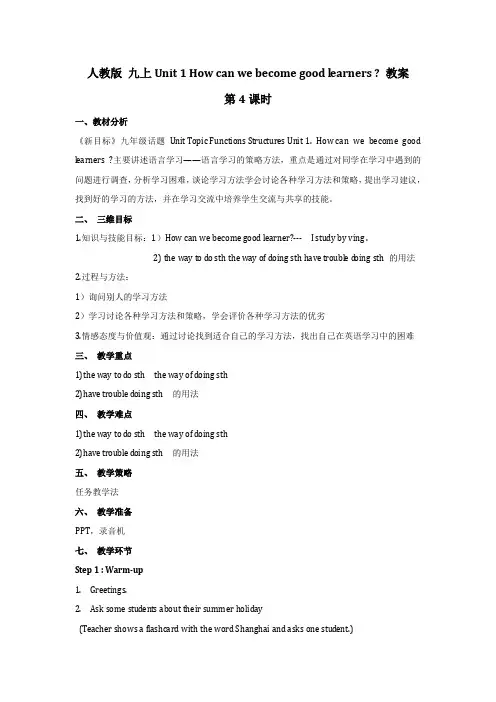
人教版九上Unit 1 How can we become good l earners ? 教案第4课时一、教材分析《新目标》九年级话题Unit Topic Functions Structures Unit 1. How can we become good learners ?主要讲述语言学习——语言学习的策略方法,重点是通过对同学在学习中遇到的问题进行调查,分析学习困难,谈论学习方法学会讨论各种学习方法和策略,提出学习建议,找到好的学习的方法,并在学习交流中培养学生交流与共享的技能。
二、三维目标1.知识与技能目标:1)How can we become good learner?--- I study by ving .2) the way to do sth the way of d oing sth have troubl e d oing sth 的用法2.过程与方法:1)询问别人的学习方法2)学习讨论各种学习方法和策略,学会评价各种学习方法的优劣3.情感态度与价值观:通过讨论找到适合自己的学习方法,找出自己在英语学习中的困难三、教学重点1)the way to do sth the way of d oing sth2)have troubl e d oing sth 的用法四、教学难点1)the way to do sth the way of d oing sth2)have troubl e d oing sth 的用法五、教学策略任务教学法六、教学准备PPT,录音机七、教学环节Step 1 : Warm-up1. Greetings.2. Ask some students about their summer holiday(Teacher shows a flashcard with the word Shanghai and asks one student.)Teacher shows the others and teaches the word “flashcard” to the stud ents.Step 2: RevisionRead and translate some words they have learned.Step3.PresentationI. Language StudyTeacher writes the pattern on the blackboard:-- How d o you study for an English test?-- I study for a test by + V.-ingMake a list of their answers on the blackboard. Teacher can teach the “vocabulary” and “pronunciation” at the right time.II. 1a1.Check the answers, after checking, read the ways to the students and ask students to put up their hands to show which things they checked. Count the numbers.2. Ask stud ents to write down other ways they study for an English test. Then ask some to read their ways to the class.III. 1b1. Play the tape.2. Check the answers with the students.3. Read the sample answer to the class and ask students to say the other two.Step4 Consolidation and extension 1. Read the instructions and the conversation to the class, and then ask students to make similar conversations.2. Ask some pairs to present their conversations.3. Small competition: group in four, make sentences using structure (verb + by/with gerund).4.Make a survey : one student interview other stud ents using the structures (How do you study …? I study by + v-ing .)Show the results.Step5 Summary1.How是用来提问“怎么,怎样”的疑问词,引导一个特殊疑问句,经常用by加动词的Ving 形式,表示“通过……方式,方法”或“借助某种手段”例如:How d o you usually go to school ?I go to school by bus。
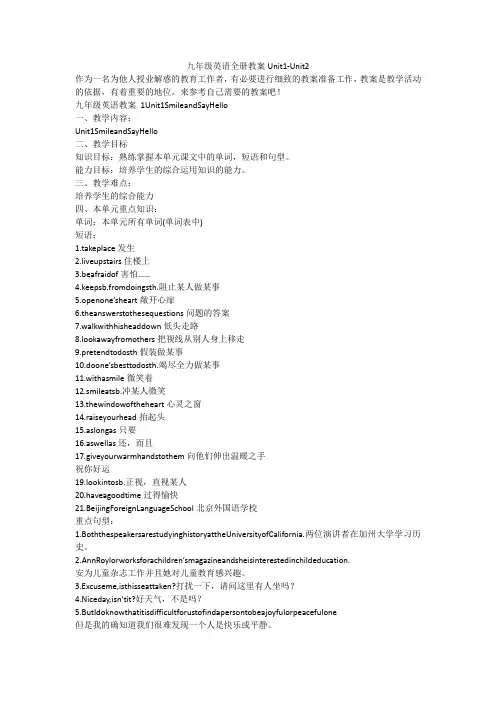
九年级英语全册教案Unit1-Unit2作为一名为他人授业解惑的教育工作者,有必要进行细致的教案准备工作,教案是教学活动的依据,有着重要的地位。
来参考自己需要的教案吧!九年级英语教案1Unit1SmileandSayHello一、教学内容:Unit1SmileandSayHello二、教学目标知识目标:熟练掌握本单元课文中的单词,短语和句型。
能力目标:培养学生的综合运用知识的能力。
三、教学难点:培养学生的综合能力四、本单元重点知识:单词:本单元所有单词(单词表中)短语:1.takeplace发生2.liveupstairs住楼上3.beafraidof害怕……4.keepsb.fromdoingsth.阻止某人做某事5.openone’sheart敞开心扉6.theanswerstothesequestions问题的答案7.walkwithhisheaddown低头走路8.lookawayfromothers把视线从别人身上移走9.pretendtodosth假装做某事10.doone’sbesttodosth.竭尽全力做某事11.withasmile微笑着12.smileatsb.冲某人微笑13.thewindowoftheheart心灵之窗14.raiseyourhead抬起头15.aslongas只要16.aswellas还,而且17.giveyourwarmhandstothem向他们伸出温暖之手祝你好运19.lookintosb.正视,直视某人20.haveagoodtime过得愉快21.BeijingForeignLanguageSchool北京外国语学校重点句型:1.BoththespeakersarestudyinghistoryattheUniversityofCalifornia.两位演讲者在加州大学学习历史。
2.AnnRoylorworksforachildren’smagazineandsheisinterestedinchildeducation.安为儿童杂志工作并且她对儿童教育感兴趣。
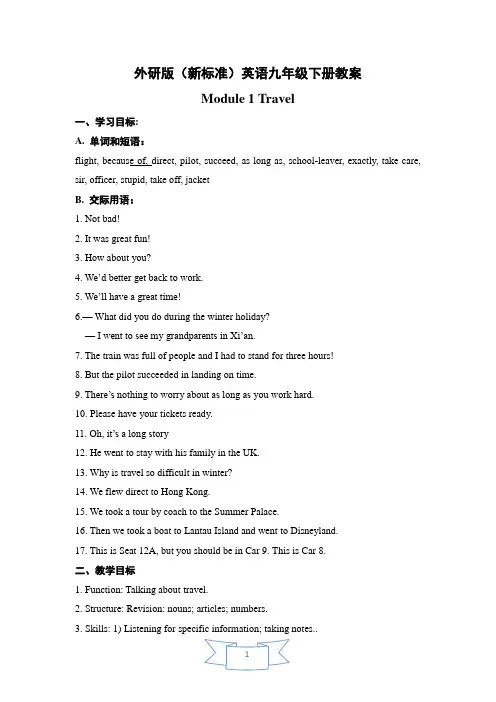
外研版(新标准)英语九年级下册教案Module 1 Travel一、学习目标:A. 单词和短语:flight, because of, direct, pilot, succeed, as long as, school-leaver, exactly, take care, sir, officer, stupid, take off, jacketB. 交际用语:1. Not bad!2. It was great fun!3. How about you?4. We’d better get back to work.5. We’ll have a great time!6.— What did you do during the winter holiday?—I went to see my grandparents in Xi’an.7. The train was full of people and I had to stand for three hours!8. But the pilot succeeded in landing on time.9. There’s nothing to worry about as long as you work hard.10. Please have your tickets ready.11. Oh, it’s a long story12. He went to stay with his family in the UK.13. Why is travel so difficult in winter?14. We flew direct to Hong Kong.15. We took a tour by coach to the Summer Palace.16. Then we took a boat to Lantau Island and went to Disneyland.17. This is Seat 12A, but you should be in Car 9. This is Car 8.二、教学目标1. Function: Talking about travel.2. Structure: Revision: nouns; articles; numbers.3. Skills: 1) Listening for specific information; taking notes..2) Talking about familiar topics (holidays)3) Predicting; reading for specific information .4) Writing a short play about a trip.4. Around the world: The first pilot to fly alone across the Atlantic Ocean.5. Task: Writing and acting out a short play.三、重点及难点:Grammar: Revision: nouns; articles; numbers.四、教学设计:Unit 1 We toured the city by bus and by taxi.Ⅰ Teaching modelListening and speakingⅡ Teaching methodCommunicative approachⅢ Teaching aims1. To understand the conversations conversation with regard to “travel”.2. To talk about one’s holiday and new term..Ⅳ Teaching Objectives1. Key vocabulary: flight, because of, direct, pilot, succeed, as long as, school-leaver,exactly2. Key structures: Sentence structureⅤ Teaching aidsTape recorder, OHP, videoⅥ Teaching StepsStep 1 Warming up1. Show some pictures to talk.1) — How do you go to school / work?— I go to school by ______.2) — How do you most like to travel by?— I most like to travel by _________.3. Show some pictures to introduce the new words.4. Learn the new words.5. Read the words after the teacher.Step 2 Complete the sentences.1. Ask the students to read through the sentences in Activity 1.1) I most like to travel by _____________.2) I least like to travel by _____________.3) I travel most often by ______________.4) I travel least often by ______________.2. Complete the sentences so they are true for you.3. Ask the students to check their answer with a partner.4. Call back the answers from the whole class and check the answers.Step 3 Listening practice.1. Ask the students to read through the sentences in Activity2.1) The flight takes about __________ hours.2) Time difference: __________ hours.3) Flight number: __________4) From _________ to _________5) Leave at (new time): _________6) Arrive at (new time): _________Keys: 10, 8, CA938, London, Beijing, 11:30, 5:30 p.m.2. Play the tape and ask the students to listen to the tape carefully.3. Listen and complete the notes.4. Ask the students to check their answer with a partner.5. Call back the answers from the whole class and check the answers.Step 4 Listen and read.1. Ask the students to listen and read the conversation silently.When you listen to the recording, try to note down the key information. Your notes will then help you retell the main information.2. Now complete the table.Holiday activitiesLingling went to see her grandparents in Henan Province by trainTonyDamingBetty4. Ask the students to check their answer with a partner.5. Call back the answers from the whole class and check the answers.Keys:went to stay with his family in the UK by plane.flew to Hong Kong and visited Lantau Island Disneyland.toured Beij ing by bus and by taxi and took a tour by coach to the Summer Palace. Step 5 Answer the questions.1. Ask the students to read through the questions in Activity 4.1) When do you think the conversation takes place?2) According to Lingling, why is travel so difficult in winter?3) What are Daming and Betty looking forward to at the end of the term?2. Answer the questions.3. Ask the students to check their answer with a partner.4. Call back the answers from the whole class and check the answers.Keys:1. The conversation takes place in winter.2. Travel is difficult because of the Spring Festival.3. They are looking forward to the school-leavers’ party.Step 6 Choose the correct answer.1. Ask the students to read through the words in the box in Activity 5.direct exactly pilot succeed2. Choose the correct answer.1. When you fly direct, you ______.a) arrive without stopping at another place2. When you say “Exactly”, it means ______.a) you do not agreeb) you completely agree3. The pilot of plane ______.a) flies itb) gives you food and drink during the flight4. If you succeed in doing something, you ______.a) manage to do itb) nearly do it3. Ask the students to check their answer with a partner.4. Call back the answers from the whole class and check the answers.Keys: 1. a 2. b 3. a 4. aStep 7 Everyday EnglishNot bad!It was great fun!How about you?We’d better get back to work.We’ll have a great time!Step 8 Pronunciation and speaking: Listen and mark the pauses.1. Play the recording once without stopping.2. Play the recording again and ask the whole class to repeat.Lingling: How about you, Betty?Betty: We had quit a good time in Beijing. We toured the city by bus and by taxi. Last weekend, we took a tour by coach to the Summer Place and went for a long walk around the lake.Lingling: That soun ds great! But now, we’d better get back to work . We’re going to have a big exam at the end of the term.3. Ask the students to listen and mark the pauses.4. Now listen again and repeat.Step 9 Work in groups.Talk about your winter holiday.1. Ask and answer about what you did during the winter holiday.— What did you do during the winter holiday?— I went to see my grandparents in Xi’an.2. Talk about what happened during the trip.The train was full of people and I had to stand for three hours!Step 10 Language points1. But the pilot succeeded in landing on time. 不过飞行员成功地按时着陆了。
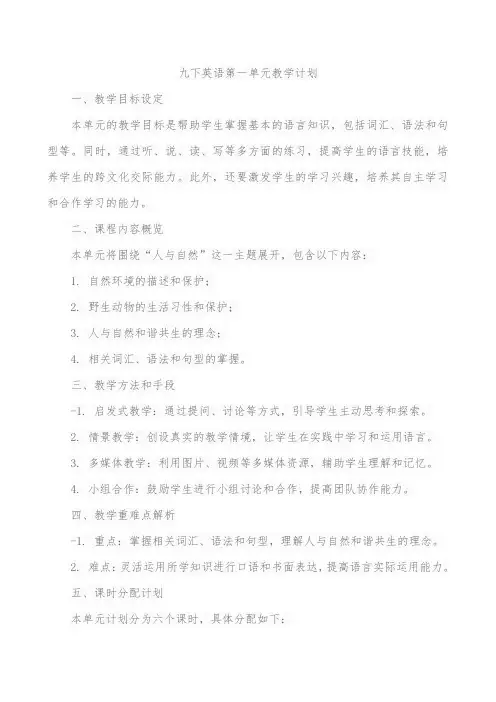
九下英语第一单元教学计划一、教学目标设定本单元的教学目标是帮助学生掌握基本的语言知识,包括词汇、语法和句型等。
同时,通过听、说、读、写等多方面的练习,提高学生的语言技能,培养学生的跨文化交际能力。
此外,还要激发学生的学习兴趣,培养其自主学习和合作学习的能力。
二、课程内容概览本单元将围绕“人与自然”这一主题展开,包含以下内容:1. 自然环境的描述和保护;2. 野生动物的生活习性和保护;3. 人与自然和谐共生的理念;4. 相关词汇、语法和句型的掌握。
三、教学方法和手段-1. 启发式教学:通过提问、讨论等方式,引导学生主动思考和探索。
2. 情景教学:创设真实的教学情境,让学生在实践中学习和运用语言。
3. 多媒体教学:利用图片、视频等多媒体资源,辅助学生理解和记忆。
4. 小组合作:鼓励学生进行小组讨论和合作,提高团队协作能力。
四、教学重难点解析-1. 重点:掌握相关词汇、语法和句型,理解人与自然和谐共生的理念。
2. 难点:灵活运用所学知识进行口语和书面表达,提高语言实际运用能力。
五、课时分配计划本单元计划分为六个课时,具体分配如下:1. 第一课时:导入新课,学习相关词汇和句型。
2. 第二课时:深入理解课文内容,进行听力和口语练习。
3. 第三课时:学习语法知识,进行笔头练习。
4. 第四课时:复习前面所学内容,进行小组讨论和展示。
5. 第五课时:综合运用所学知识,进行写作练习。
6. 第六课时:总结本单元内容,进行综合评价和反馈。
六、学生活动设计1. 口语练习:组织学生进行角色扮演、对话等活动,提高口语表达能力。
2. 笔头练习:布置作业和练习题,巩固所学知识和技能。
3. 小组讨论:鼓励学生进行小组讨论和展示,培养团队协作和沟通能力。
七、教学评价策略1. 形成性评价:通过课堂表现、作业完成情况等方式,及时了解和评价学生的学习情况。
2. 终结性评价:通过单元测试、期末考试等方式,全面评价学生的语言知识和技能掌握情况。
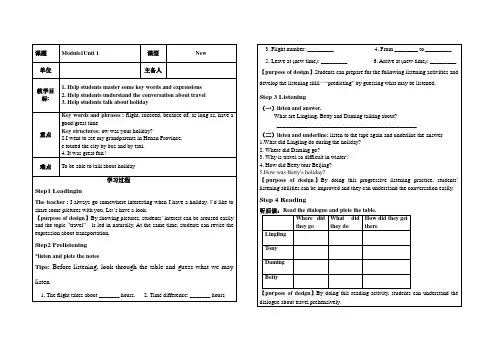
人教版英语初三下册全册教案Unit 1 How do you study for a test ?Section A (1a-2c)Teaching aims :1.Let the students learn the ways of studying .2.Grasp some knowledge points .Teaching steps:Step1.(7‘)1. Read the phrases in 1a, check the ways of your studying .2. Practice like this :How do you study for a test ?S1: I study by listening to tapes .S2: I study by asking the teacher for help .S3: I study by ….Step2.(5‘)1.Listen to the tape twice ,and finish 1b (5‘)2.Let two Ss come to the blackboard, and write their answers on it.3. Check the answersStep3.(10‘)1. Listen to the tape twice , and finish 2a and 2b2.Let two Ss come to the blackboard, and write their answers on it.3. Check the answersStep4.(13‘)1. Practice in class .Make dialogs in pairs according to 2a and 2b .2.Act them out .Class exercises(10’)一.用括号内所给单词的正确形式填空。
第 5 单元第8 课时教学设计课题名称RevisionTeaching aims:To review key grammar and vocabulary itemsTo give students the chance to practise the grammar and vocabulary itemsTo allow students to check their progress and ask any questions they may still have Teaching difficult and important points:To review key grammar and vocabulary itemsTo check their progress and tr y to ask questions they may haveTeaching proceduresStep 1 Warming-upl talk about Tan Dun and his music2 use the new words to talk about an art form3 give reasons with because,since and as4 guess the meaning of a word from the contextStep2 review the readingpresent 动词“颁发,授予,尤指在某种仪式上颁发,授予”eg: He was invited to present the prizes at the Model Contest. 他授邀在模特大赛上颁奖。
固定搭配:present with sth/ present sth to .将某物授予某人。
winner 作为可数名词,表示“获胜者”eg: Who’s the winner of the tennis match.这次网球赛的获胜者是谁?Win 是动词,表示“赢,赢得”interest 在此作可数名词,“兴趣”。
Unit1 Reading 精品教案一、教学目标1. 识别病了解与北京和桂林有关的词汇。
2. 完成文后B、C、D、E部分的练习。
3. 激发学生的爱国热情。
二、教学内容1. 掌握词汇:middle, emperor, raising, flag, landscape, attraction, watchtower, wonder, lie, shape, underground, cave, hang, point, upwards, hire, eastern, south-east, location。
词组:the capital of, in the middle of, used to, turn into, be worth doing, the raising of the national flag, run for, across northern China, on the two sides of, in dif-ferent shapes, hang down, point upwards, take a boat trip in the past, an old saying, be famous for。
句型:The emperors of the Ming and Qing dynasties used to live there.With wonderful buildings and art treasures inside, it is well worth a visit.Many tourists like to gather there early in the morning to watch the raising of the national flag.It runs for over 6,000 kilometers across northern China, with watchtowers every few hundred meters.It is one of the wonders of the world.It lies on the two sides of the Lijiang River.It is amazing that there are so many rocks in unusual shapes - some hang down, and others point upwards.2. 掌握文章重要的语言知识点。
Unit 1 How do you study for a test一)学习目标( Language Goal)1. Talk about how to study . 学会讨论各种学习方法和策略。
2. Find out your suitable learning methods. 找出适合自己的学习方法。
二)语言结构(Language Structures)1. Verb + by with gerund by +动名词短语表示“通过, 途径,方法”2. How questions have 引导的特殊疑问句三)目标语言(Target Language)1. How do you study for tests ? 你是怎样准备考试的?Well , I study by working with my classmates.哦,我和同学们一起学习。
2. Have you ever studied with a group ?你曾经参加过学习小组吗?Yes , I have . I 'nevdealeloatr that way .是的,参加过。
通过这种方式我学了许多。
3. I don ' t have a partner to practice English with . 我没有同伴可以练习英语。
Maybe you should join an English club. 或许,你应该参加一个英语俱乐部。
4. What about reading aloud to practice pronunciation ? 大声朗读来练习发音怎么样?Why don ' t you join an English language club ?你为什么不参加一个英语俱乐部呢?四)Key words and phrases (重点词汇)1. flashcard n. 抽认卡2. frustrating a. 令人沮丧的3. memorize v. 记忆,背诵4. aloud adv. 出声地、高声地5. comma n. 逗号6. pronunciation n. 发音7. solution n. 解决办法8. not at all 根本(不)全然(不)9. end up 结束,告, 终10. make mistakes 犯错11. later on 以后;随后12. be afraid to 害怕去做13. laugh at sb. 笑话;取笑(某人)14. take notes 做笔记,做记录15. enjoy doing sth . 喜欢做, 乐意做,16. native speaker说本族语的人17. make up组成、构成(四)重点、难点:(Key pointsand difficulties )1. by介词,表示“通过,方法或途径”的意思,译成“靠、通过” by后面可以加名词或动名词短语eg.(1)The house was destroyed by fire.房屋被火烧毁了。
(2)travel by air (la nd , sea)航空(陆路、航海)旅行。
(3)go by train (boat , bus)乘火车(船,公共汽车)去(4)shake sb by the hand 和某人握手(5)I study English by watching English movies. 我通过看英文电影学英语。
另外,by做为介词的含义有很多,我们也已经学习过一些用法,总结如下(1)在,旁边、靠近eg. There is a power station by the river. 河边有一个电厂。
(2)沿着、经由eg. come by the highway 由公路来(3)由于eg. by mistake由于差错(4)被、由eg. some articles written by Luxun. —些由鲁迅写的文章(5)(表示面积)eg. a room 5m,by4m 一间长五米宽四米的房间(6)逐批eg. One by one 一个接一个(7)表示方法、途径如上2. “ How ” questionsHow引导特殊疑问句,有两种含义(1)表示问候eg. How do you do ?How are you ?How' s everyth ing going ?(2)表示“怎样”eg. How is your new house ?你的新房子怎么样?It ' s great.它太棒了。
How do you lear n En glish ?你是怎样学英文的?I lear n En glish by read ing lots of En glish magaz in es.我通过读大量英文杂志学习英文。
请同学们注意how和what引导的疑问句是不一样的,不能混淆。
how通常对程度或方式进行提问,意为“怎么样”,回答通常做状语或表语,what常对动作的发出者或接受者进行提问,意为“什么”,回答通常主语或宾语。
试比较:(1)How is your summer holiday ? It is perfect. (表程度,表语)(2)How did you travel around the world ?I travelled by bike. (表方式,状语)(3)W hat do you learn at school ?I lear n Chin ese , En glish , Maths and other subjects.(学习的科目,做宾语)3. 在这一单元中出现的话题是“讨论如何学习”。
这个话题既有趣又实用,既能锻炼我们的口语表达能力,又能使我们学到一些实用的方法,对自身的学习大有帮助。
如何向别人请教学习方法呢?又如何回答呢?请诵读下面的目标句型:How do you study En glish ? (运用特殊疑问句)I study by liste ning to cassetts. (听录音带)I study by study ing with a group. (和小组一起学习)by watch ing En glish programs on TV. (看英语电视节目)by enjoying En glish son gs. (听英文歌)by tak ing part in En glish classes after school . (上课外英语班)by gett ing an En glish tutor. (请英语家教)by readi ng En glish magaz ines and n ewspaper . (读英文杂志、报纸)by surfing the intern et. (网上冲浪)by maki ng flashcards.(制作单词认读卡片)by readi ng the textbook.(读教科书)by ask ing the teacher for help. (请教老师)by making vocabulary lists. (列单词表)by tak ing no tes carefully . (认真记笔记)by havi ng the En glish class carefully . (认真上课)by finishing my homework seriously . (认真完成作业)Do you learn English by , ?(用一般疑问句)Yes , I do . / No , I don ' t.Have you ever studied with a group ? (用完成时态)Yes , I have . I ' ve learned a lot that way.What about listening to cassettes ?[用what about +动名词提问]I do that sometimes. I think it helps.4. 学会评价各种学习方法的优劣(Comment on the ways of learning English )看到了上面各种各样的学习方法,有些眼花缭乱。
其实,并不是所有的方法都适合自己。
我们要学会判断、评价,然后才能选择最适合自己的用哪些语言才能表达自己的评价呢?请看下面的目标句型:I think studying English by , is, because ,女口:I think studying English by working with a group is a good way because you can ask others whe n you have questi ons.I think surfing the internet is a bad way because you have to use a computer and always waste your time.这个句型较长是个复合句,出现了由because引导的原因状语从句。
进入初三后,我们在写作表达时,要避免再使用仅仅由because引导的句子,而要写完整的句子。
女口:不能写Because I slept late .意思不完整,不清晰要写成I missed the early bus because I slept late .这样,有原因,有结果,才是完整的句子。
5. 找出自己在英语学习中的困难(Find out your own difficulties in learning English )要选择适合自己的学习方法,还必须清楚自己的困难所在,然后才能有的放矢。
lear ning En glish can be difficult . What things are difficult for you ?我们如何来表达自己学习与遇到的困难呢?如何给出建议呢?请诵读下面的目标句型:说出困难:I have a problem . I can ' t remember the new words.I can ' t pronounce some of the words.I can ' t understand spoken English .I always make mistakes in grammer.I read very slowly.I don ' t know how to speak English well.给出建议:You should read En glish aloud.Liste ning can help.Why don ' t you join an English Ianguage club to practice speaking.Would you mind rememberi ng new words by flashcards.Please try to talk with your friends in En glish as much as possible.(请注意不同句式的运用)6. 选择适合自己的学习方法( Choose your suitable learning ways)通过以上各个环节的学习,我们终于可以完成最后的目标一一选择适合自己的方法。